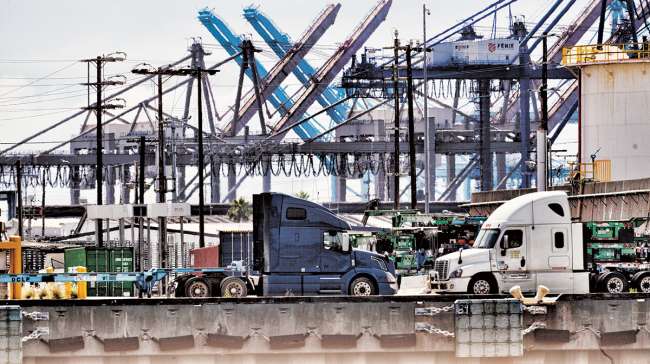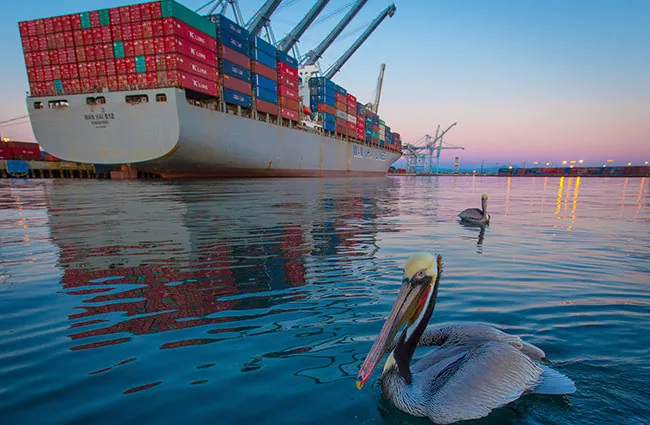Staff Reporter
Ports Report More Volume Gains for April

[Stay on top of transportation news: Get TTNews in your inbox.]
U.S. ports continued to see year-over-year container volume increases in April.
The Port of Los Angeles reported processing 770,337 20-foot equivalent units, a 12% improvement from 688,109 in 2023 and the ninth consecutive month of year-over-year growth. Container volumes for the first four months increased 25% to 3,150,841.
“All our vital operational statistics at the Port of Los Angeles are at or better than pre-COVID levels,” Executive Director Gene Seroka said during a media briefing. “I’ve been urging shippers to take advantage of our fluid terminals and excess capacity. We’re ready to upscale on demand as we move into the second half of 2024.”
ICYMI: #PortofLA handled 770,337 container units in April 2024, a 12% increase over the previous year. Four months into 2024, waterfront workers have efficiently processed 3,150,841 container units across L.A. marine terminals –– nearly 25% more than 2023. https://t.co/b65wExY3wH pic.twitter.com/tL63bZHtnA — Port of Los Angeles (@PortofLA) May 22, 2024
The Port of Long Beach said container volume for the month increased 14.4% year-over-year to 750,424 containers from 656,049, marking the eighth straight month of year-over-year cargo growth. Container volume for the first four months rose 15.8% to 2,753,244.
“Imports are steadily climbing as we continue to work with industry partners to rebuild our market share,” Port of Long Beach CEO Mario Cordero said. “We are strengthening our competitiveness with our brand of operational excellence, customer service and ongoing infrastructure investments that will keep cargo moving efficiently well into the future.”

Container volume at the Port of Long Beach rose 15.8% to 2,753,244 for the first four months. (Port of Long Beach via X)
The Port of Oakland posted an 8.1% increase to 188,633 containers from 174,482, the sixth consecutive month full import volume has increased from the 2023 period. The volume of imported goods is returning to normal levels as cargo diverted during the pandemic returns to the seaport. Oakland also is seeing more agricultural shippers return in response to better schedule reliability for vessels.

Brandes
“It’s encouraging to see Oakland recover cargo volume as we focus on long-term growth,” Maritime Director Bryan Brandes said. “Our investments in upgrading port infrastructure are paying off, and they position us ideally to capture future freight business with increasing demand.”
The Northwest Seaport Alliance noted that combined volumes between the ports of Seattle and Tacoma, Wash., increased 11.3% to 258,688 units from 232,321. The alliance said full international exports have reached an eight-month growth streak. Container volume for the first four months of the year inched up 5% to 958,069.
Port Houston is committed to maintaining the Houston Ship Channel, home to the number one U.S. port for waterborne tonnage. Stay informed about our progress and how we’re shaping the future of maritime commerce: https://t.co/Xn90vEWZX9#Maritime #HoustonShipChannel #Project11 pic.twitter.com/eyF7ez2vBc — Port Houston (@Port_Houston) May 28, 2024
Port Houston posted a volume increase of 5% year-over-year to 324,177 containers from 307,879. The results were driven by imports and exports continuing to trend upward. Loaded imports increased after a surge in new import distribution centers constructed in the area. The rise in exports is attributed to the demand for regionally produced automotive, furniture, cotton and plastic resin goods. Container volume for the first four months rose 12% to 1,394,094.
Georgia Ports Authority said volume climbed 8% to 441,000 from 408,686. The port noted that diversions from the Port of Baltimore increased numbers at Colonel’s Island Terminal, in addition to organic growth. It was the third-busiest April on record for the port.

Lynch
“Asian imports remain strong, but we are also seeing an uptick in vehicle exports, new customers have chosen Georgia Ports, and we have increased capacity for existing customers,” GPA President Griff Lynch said. “Additionally, manufacturers are working to raise dealership stocks from the current 14-day inventories to 30 days’ worth of vehicles.”
South Carolina Ports Authority reported volume ticked up 0.5% to 215,058 containers from 214,101 in 2023. Port leaders noted volumes are increasing each month as more port-dependent businesses take advantage of the rail connection between the Port of Charleston and inland markets.

Melvin
“We are expanding port capacity and capabilities ahead of demand to efficiently handle goods for our customers,” SC Ports CEO Barbara Melvin said. “We are proud to offer reliable, efficient port service to the booming Southeast market.”
Port Authority of New York and New Jersey usually runs one month behind the other ports in releasing its numbers. In March, the facility experienced a 22.1% volume increase year-over-year to 701,648 containers from 574,452.
The ports of Baltimore and Virginia did not have volume numbers available at press time. Both have experienced disruptions in their operations in the aftermath of the Francis Scott Key Bridge collapse in Baltimore on March 26.
Port of Baltimore leaders have reported that cleanup efforts have cleared much of the wreckage and that the Fort McHenry Limited Access Channel has been opened to commercial vessel traffic for 24-hour availability.
Want more news? Listen to today's daily briefing below or go here for more info:




